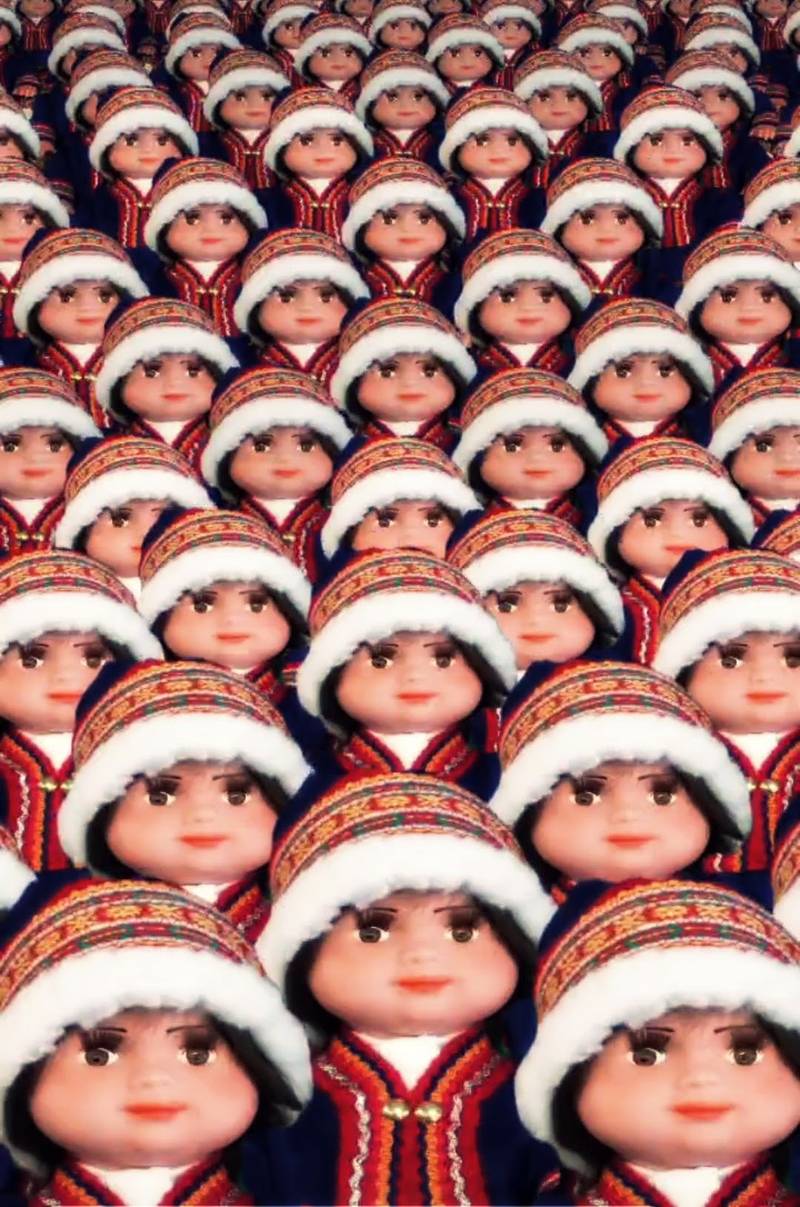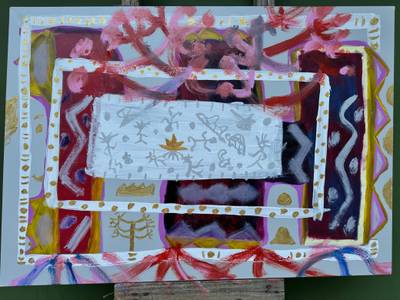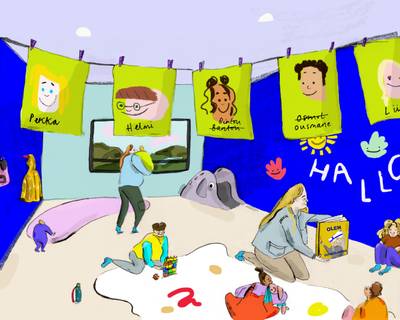

Saami dolls
Helga West, also known as Biennaš-Jon Jovnna Piera Helga, is a theologian and poet from Deatnu river valley in the Finnish side of Sápmi. West is a doctoral candidate in the University of Helsinki, and in her theology dissertation, she examines topical Sámi issues connected to reconciliation. West also works in the literature field, and is particularly interested in the potential of art to give words to painful colonial experiences. In her most recent essays, she has combined elements of Sáminess and Western pop culture.
Dolls that imitate the Sámi people - I have been observing their facial expressions, their sign language, and awkward costumes. I place the dolls in the political composition.
I play with the dolls. But, unlike when I was a kid and played with my Pocahontas Barbie, this time the playing feels odd. I try to understand the complex composition of which the dolls are a part, and of which I am part of this play. I want to understand who these dolls are imitating and for whose eyes they’re doing so. Do these bothersome dolls live up to anyone’s expectations? Whose? What exactly are those expectations, and where do they come from?
Sometimes, I feel like I am that plastic Lappish doll, the object of gaze and benevolent admiration. That when I get a silent look on my face and hear the chorus of Aqua’s 1990s smash hit “Barbie Girl”:
I'm a Barbie girl, in the Barbie world
Life in plastic, it's fantastic
You can brush my hair, undress me everywhere
Imagination, life is your creation…
I sometimes suspect that I have friends and jobs just because I am a Sámi, an exotic. I am convinced that all my boyfriends have fallen in love with me partly because I am allowed to wear charming and colorful Sámi costumes. That is hardly true, but hey! wait! no! My clothes are not costumes. Our cultures are not costumes. We are not your costumes. My Sámi dress is called gákti in North Sámi. It is my first skin. It is just that all this exotism surrounding the Sámi makes me wonder who I am and who I would be.
Being one of the only recognized Indigenous peoples in European territory, I understand why we continue to pique the interest of others. On the other hand, I must admit that since I happen to belong to a Sámi community - my life is exciting. Our cultures are exciting. Thank you, ancestors, for my exciting life. Still, it’s no coincidence why the Sámi continue to interest researchers, artists, and lonely hikers century after century. The core Sámi area in Northern Europe has been a resource land for centuries according to Saami Professor Veli-Pekka Lehtola. It seems, there is always someone who wants a Lappish doll as a keepsake. Bemused, I wonder, as a recollection of what memory exactly?
We, the Indigenous Sámi people, identify ourselves as the children of the Sun. In Northern Europe, our territory has been divided by four states, now known as Finland, Norway, Sweden, and Russia in Northern Europe. Sápmi, Sábme and Saepmie are the names we give to our territory. Sámiland crosses borders, but we think the borders are artificial. If one examines history, recent history, and perhaps the present, one can conclude that Indigenous peoples usually interest others when they possess something that others feel like fancying. Whether it’s biodata, land, medicinal plants for the use of pharmaceutical industry, minerals, shaman drums for private collections or, for example, environmental wisdom during the climate crisis. There always seems to be something that can be taken from Indigenous communities. And what can be taken, usually has been taken - a resource land of data, collected artifacts and cultural imagery including the dolls.
Dolls that imitate the Sámi can be purchased at a souvenir shop or flea market, where they usually end up. There I face these dolls, as our paths cross second-hand and intertwine into a play in the quiet hours, hidden from view. Why do I get the impression that when the dolls are abandoned, they are at their most revealing? The setting is always the same: a brightly coloured gift shelf, a shabby box, or a vague, provocative shelf.
Let us face an obscure fact: a plastic doll can be used to make politics. When looking at the dolls in the shelves, I realize that this is our place, next to an Orient and various kinds of sex symbols. Smile Indigenous, you are being objectified.
I look at their faces. These dolls imitating the Sámi have thick, black, sparkling eyes, curved eyelashes and a layer of red paint on the lips. Their facial expressions range from numb to confused to smiling, all somewhat fearful. I showed the doll photos to my friend. She looked at their faces and asked spontaneously: “Are these dolls drugged?”
It’s as if only one type of startled doll head pops out of the machinery of a Chinese doll factory. They have sparkling eyes, big cheeks and all that. Made in China or Made for China, who knows.
The machines run. The dolls are given costumes that have nothing to do with our clothes. Their outfits have nothing to do with our colors. Ones that paint the stories of our sacred rivers, pastures and hills. The dolls’ costumes only reveal the extractivist, colonial approach to my people.
Sometimes, these dolls irritate me to the point where I have secretly fantasized about organizing an art performance. I would buy all the tasteless Sámi-themed items sold in Helsinki recycling shops, and burn them spectacularly for the performance. However, because my hobbies do not require me to perform in a fiery petrol-to-flame-style I have accepted these artifacts as part of the Nordic narratives. The dolls are a story in themselves.
Please tell me, my doll, what this strange enchantment is that surrounds you, and our lands. Lapland’s magic, a nightless night and a dayless day. Is that all? The enchantment of which I am a part, a long continuum of how my people and I are perceived by others. Talk to me, doll, you need to talk to me now! But the dolls do not speak. They, on the other hand, tell their own story. They reflect the fact that there is always someone who wants a piece of us. When muted and misunderstood, they reflect my self-image. As a second-hand or take-away, take me with you.
I am here just for your curious gaze.







